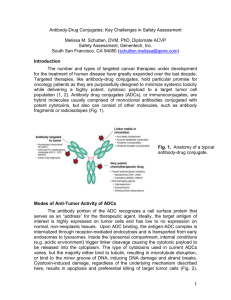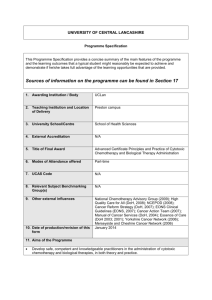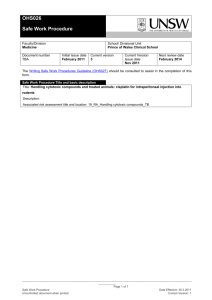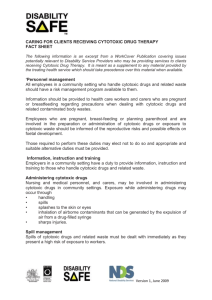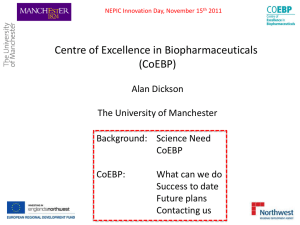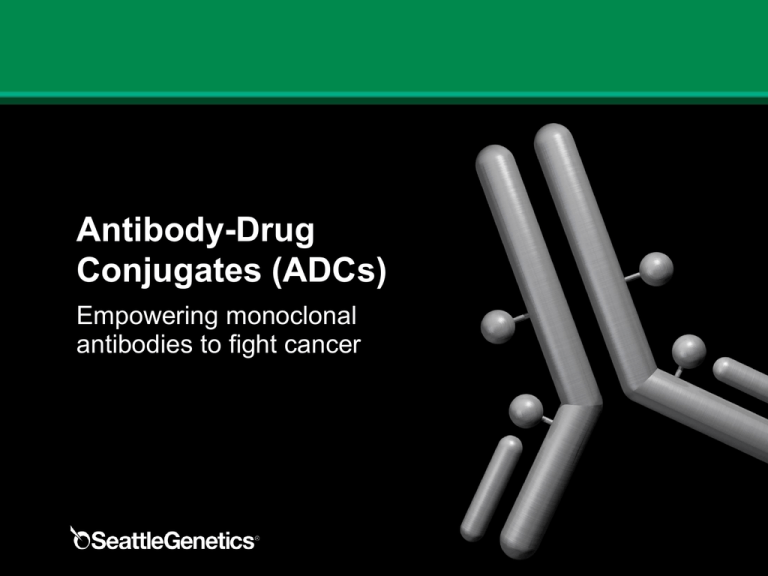
Antibody-Drug
Conjugates (ADCs)
Empowering monoclonal
antibodies to fight cancer
Disclosure / Terms and Conditions
• SEATTLE GENETICS, INC., IS PROVIDING THIS
INFORMATION FOR EDUCATIONAL PURPOSES ONLY,
AND NEITHER SEATTLE GENETICS, INC., NOR ITS
AGENTS, AFFILIATES, PARTNERS OR LICENSORS ARE
PROVIDING THIS INFORMATION TO YOU FOR THE
PURPOSES OF GIVING YOU MEDICAL ADVICE
• THE INFORMATION PRESENTED HEREIN IS
COPYRIGHTED TO SEATTLE GENETICS, INC.
• ANY CHANGES OR MODIFICATIONS TO THE CONTENT
OR THE SLIDE DECK MAY NOT BE IMPUTED TO
SEATTLE GENETICS, INC., OR ITS AGENTS, AFFILIATES,
PARTNERS OR LICENSORS
Seattle Genetics and are US registered trademarks of Seattle Genetics, Inc.
© 2012 Seattle Genetics, Inc., Bothell, WA 98021. All rights reserved.
Produced in USA 10/12
2
Elements of an Antibody-Drug Conjugate (ADC)
Antibody
Specific for a tumorassociated antigen that has
restricted expression on
normal cells.1,2
Cytotoxic agent
Linker
Attaches the cytotoxic agent
to the antibody. Newer linker
systems are designed to be
stable in circulation and
release the cytotoxic agent
inside targeted cells.1-3
Designed to kill target cells when
internalized and released.1,2
References: 1. Carter PJ et al. Cancer J. 2008;14(3):154-169. 2. Senter PD. Curr Opin Chem Biol. 2009;13(3):235-244. 3. Polson AG et al.
Cancer Res. 2009;69(6):2358-2364.
3
Monoclonal Antibodies Have Activity
as Single Agents
• High degree of specificity for tumor antigens1
• Generally well-tolerated2
• Long half-life resulting in longer systemic exposure2
Act through direct signaling, recruitment of cytotoxic effector cells and complement fixation1,2
Apoptosis through direct
intracellular signaling3
Tumor lysis through
host immune effector cells3
References: 1. Ducry L et al. Bioconjug Chem. 2010;21(1):5-13. 2. Carter P et al. Am Assoc Cancer Res Educ Book. 2005;2005(1):147-154.
3. Sharkey RM et al. CA Cancer J Clin. 2006;56(4):226-243.
4
Rationale for ADCs:
to Expand the Therapeutic Window
• ADCs are designed to target delivery of a cytotoxic agent
− Increase the delivery of a cytotoxic agent to a tumor
− Limit tissue exposure to free cytotoxic agent
Conventional
Antibody-DrugChemotherapy
Conjugates
Reference: Carter PJ et al. Cancer J. 2008;14(3):154-169.
5
Target Antigen Should Be Expressed
on Tumor Cells Compared to Healthy Cells
Target antigen
Expressed
on tumor cells1,2
Limited or no expression on
normal or vital tissues1,2
• Efficient internalization of target antigen increases drug delivery
and enhances cell-killing1,3
References: 1. Alley SC et al. Curr Opin Chem Biol. 2010;14(4):529-537. 2. Carter PJ et al. Cancer J. 2008;14(3):154-169. 3. Polson AG et al.
Expert Opin Investig Drugs. 2011;20(1):75-85.
6
Primary Mechanism of Action of ADCs:
Targeted Delivery of a Cytotoxic Agent
Reference: Carter PJ et al. Cancer J. 2008;14(3):154-169.
7
Other Potential ADC Antitumor Activities
Some ADCs may retain mAb-mediated anticancer activities1,2
Apoptosis through direct
intracellular signaling3
Tumor lysis through
host immune effector cells3
References: 1. Carter PJ et al. Cancer J. 2008;14(3):154-169. 2. Junttila TT et al [published online ahead of print August 21, 2010]. Breast Cancer Res
Treat. doi:10.1007/s10549-010-1090-x. 3. Sharkey RM et al. CA Cancer J Clin. 2006;56(4):226-243.
8
ADCs Link Precision and Potency
for Greater Activity
In vivo Activity of an ADC and its Components in a Xenograft Mouse Model
Untreated
Nonbinding ADC Control
Antibody Alone (mAb)
Admixture (mAb + Cytotoxic Agent Unlinked)
ADC (Cytotoxic Agent Linked to mAb)
5/5 Complete
Response (CR)
This preclinical study demonstrated that the ADC is more active
than the antibody alone or the admixture
Reference: Doronina SO et al. Nat Biotechnol. 2003;21(7):778-784.
9
Current ADCs are the culmination
of decades of scientific investigation
Improved by incorporation of:1,2
− A more potent cytotoxic agent*
− A more stable linker
− Optimized ratio of cytotoxic
agents per antibody
* As demonstrated in preclinical models.
References: 1. Alley SC et al. Curr Opin Chem Biol. 2010;14(4):529-537. 2. Hamblett KJ et al. Clin Cancer Res. 2004;10(20):7063-7070.
10
As Demonstrated In Preclinical Models,
Next-Generation ADCs Link the Proven Selectivity of
Monoclonal Antibodies With Potent Cytotoxic Agents
Linking individual elements for greater activity
• Selective delivery via mAbs1
• More potent cytotoxic agents2
• Stable linkers increase target specificity and reduce toxicity1,3
References: 1. Ducry L et al. Bioconjug Chem. 2010;21(1):5-13. 2. Alley SC et al. Curr Opin Chem Biol. 2010;14(4):529-537.
3. Doronina SO et al. Nat Biotechnol. 2003;21(7):778-784.
11
References
• Alley SC, Okeley NM, Senter PD. Antibody-drug conjugates: targeted drug delivery for cancer. Curr Opin Chem Biol. 2010;14(4):529-537.
• Boyer MJ, Tannock IF. Cellular and molecular basis of drug treatment for cancer. In: Tannock IF, Hill RP, Bristow RG, Harrington L, eds.
The Basic Science of Oncology. 4th ed. New York, NY: McGraw-Hill; 2005:349-375.
• Carter P, McDonagh CF. Designer antibody-based therapeutics for oncology. Am Assoc Cancer Res Educ Book. 2005;2005(1):147-154.
• Carter PJ, Senter PD. Antibody-drug conjugates for cancer therapy. Cancer J. 2008;14(3):154-169.
• Doronina SO, Toki BE, Torgov MY, et al. Development of potent monoclonal antibody auristatin conjugates for cancer therapy.
Nat Biotechnol. 2003;21(7):778-784.
• Dubowchik GM, Walker MA. Receptor-mediated and enzyme-dependent targeting of cytotoxic anticancer drugs. Pharmacol Ther.
1999;83(2):67-123.
• Ducry L, Stump B. Antibody-drug conjugates: linking cytotoxic payloads to monoclonal antibodies. Bioconjug Chem. 2010;21(1):5-13.
• Francisco JA, Cerveny CG, Meyer DL, et al. cAC10-vcMMAE, an anti-CD30–monomethyl auristatin E conjugate with potent and selective
antitumor activity. Blood. 2003;102(4):1458-1465.
• Hamblett KJ, Senter PD, Chace DF, et al. Effects of drug loading on the antitumor activity of a monoclonal antibody drug conjugate.
Clin Cancer Res. 2004;10(20):7063-7070.
• Junttila TT, Li G, Parsons K, Phillips GL, Sliwkowski MX. Trastuzumab-DM1 (T-DM1) retains all the mechanisms of action of trastuzumab
and efficiently inhibits growth of lapatinib insensitive breast cancer [published online ahead of print August 21, 2010]. Breast Cancer Res
Treat. doi:10.1007/s10549-010-1090-x.
• Polson AG, Calemine-Fenaux J, Chan P, et al. Antibody-drug conjugates for the treatment of non–Hodgkin’s lymphoma: target and linkerdrug selection. Cancer Res. 2009;69(6):2358-2364.
• Polson AG, Ho WY, Ramakrishnan V. Investigational antibody-drug conjugates for hematological malignancies. Expert Opin Investig Drugs.
2011;20(1):75-85.
• Senter PD. Potent antibody drug conjugates for cancer therapy. Curr Opin Chem Biol. 2009;13(3):235-244.
• Sharkey RM, Goldenberg DM. Targeted therapy of cancer: new prospects for antibodies and immunoconjugates. CA Cancer J Clin.
2006;56(4):226-243.
• Siu LL, Moore MJ. Pharmacology of anticancer drugs. In: Tannock IF, Hill RP, Bristow RG, Harrington L, eds. The Basic Science
of Oncology. 4th ed. New York, NY: McGraw-Hill; 2005:322-348.
• Trail PA, Bianchi AB. Monoclonal antibody drug conjugates in the treatment of cancer. Curr Opin Immunol. 1999;11(5):584-588.
12

